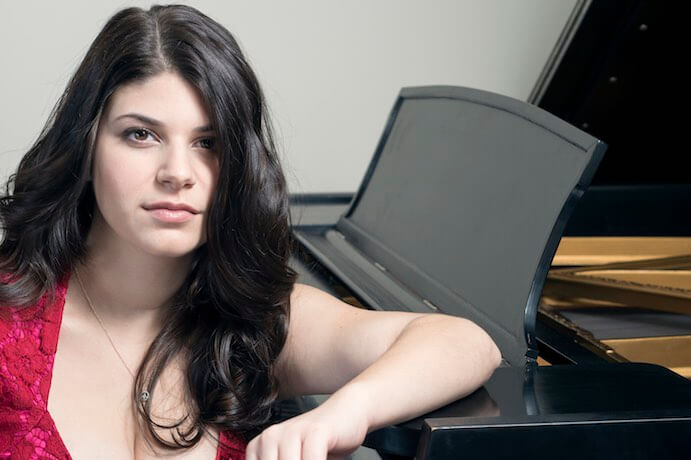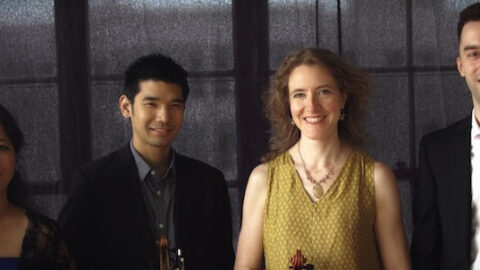The annual Momenta Festival, now in its third iteration, got off to a great start on October 1, 2017 with its program “Air from Another Planet,” curated by violinist Emilie-Anne Gendron. The quartet performed six works whose dates ranged from 1676 to 2017 and whose textures ranged from solo violin to the full Momenta Quartet accompanied by theremin. Gendron wrote in her program notes that what these six works have in common is a shared introspection that, for listeners, materializes in the form of a “manipulation of our sense of time and space.” A murkiness enshrouded the theater at Dixon Place as the evening unfolded according to this “unearthly” agenda and the Quartet slid fluidly from one sound world to another. Gendron’s flawless solos were complemented by the works she played with the other members of Momenta: violinist Alex Shiozaki, violist Stephanie Griffin, and cellist Michael Haas, all of whom performed with the skillful sensitivity we have come to expect from the ensemble.
Gendron began with two solo violin works that spin out a set of variations from a recurring theme or musical idea, with the first serving as the perfect foil for the second. Biber’s Rosary Passacaglia (1676) was followed by Alyssa Weinberg’s Unstrung (2017) in its New York premiere, and I was initially skeptical of the pairing. How wrong I was to assume that Biber’s Passacaglia was programmed as a gratuitous (even cliché) early music jam amid a sea of contemporary works. Not only was Gendron’s rendering of the Baroque composition totally stunning, but it was a truly brilliant match with Unstrung in both musical and emotional sensitivity. Both works work through musical variations as metaphors for different sorts of manifestations of psychological distress. Gendron brought a beautiful sense of pain to Biber’s musicalization of “struggles of faith” as well as to Weinberg’s musicalization of “the physicality of anxiety,” with recurring tremolos unraveling into glissandos and scrapes and hops. Weinberg’s frenetic yet cohesive musical language perfectly captured the sensation of feeling your body overtaken by the anxiety inhabiting your mind.

The audience was whisked back to the seventeenth century, visually if not sonically, for Michael Small’s White Space–Meditation on Saenredam (2015). Small’s quartet was inspired by Pieter Jansz Saenredam’s 1645 Interior of the Buurkerk at Utrecht, and the painting was projected onto the wall behind Momenta as they performed the pleasant and occasionally haunting piece. Thereminist Elizabeth Brown joined the Quartet for her own composition, Piranesi (2007/2012) as well as for her reworking of Schoenberg’s “Rapture” from his String Quartet no. 2, opus 10 (1907-1908) for theremin and string quartet (rather than the original soprano with string quartet). Both pieces were expertly played by the Quartet, whose powerful dynamic was amplified by Brown’s wobbling and whirring on theremin. A silent film by Lothar Osterburg served as the visual accompaniment for Piranesi, but the shifting castles and stairwells neither served nor hindered the overall experience. As is so often the case with new music projections, the film ultimately felt like an unnecessary distraction.
The highlight of the evening was Kee Yong Chong’s Silence Cosmos (2005). The quartet wove together bowed and plucked sounds from the players’ instruments with a verbal tapestry of whispering, hissing, humming, and the occasional shout. The mirroring of instrumental voice with vocal expression (and vice versa) unfolded into a captivating dialogue of sound and physicality. Chong’s quartet, prefaced with a poem by the Tang Dynasty poet Chen Ziang, is a musical conveyance of what Gendron describes as “a dialectical struggle of coexisting opposites–movement and stillness.” The erratic composition would not have been safe in the hands of just any players, and so it was a thrill to watch and listen to the Momenta Quartet bringing it to life so tautly and viscerally.
























